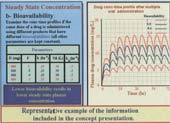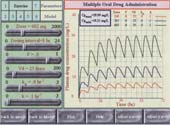
|
 |
 |
About the Program |
The Pharmacokinetic Program
The primary objective of developing this program is to use the capability of computers to illustrate the different pharmacokinetic concepts. The entire program can run with a computer mouse and does not require any special computer skills to operate.
The program consists of three parts:
- The Basic Pharmacokinetic concepts
 This is a self-instructional pharmacokinetic computer-based program consists of 23 different modules. Each module covers one topic. This is a self-instructional pharmacokinetic computer-based program consists of 23 different modules. Each module covers one topic.
This part of the program won the
American Association of Colleges of Pharmacy
Innovation in Teaching Award.
Each module consists of three parts: The concept presentation, which includes an introduction to the concept. This part relays mainly on graphics, and simulations with small amount of text to simplify the concept. The second part is a simulation exercise, which allows the user to change the value of, one or more of the pharmacokinetic parameters and plots the plasma concentration-time profile. The third part is self-assessment questions that give immediate feedback about the user's performance.
- Pharmacokinetic Simulations
 This part of the program allows the user to simulate the plasma concentration-time profiles for 37 different pharmacokinetic models on linear and semilog scales. This part of the program allows the user to simulate the plasma concentration-time profiles for 37 different pharmacokinetic models on linear and semilog scales.
This part of the program is currently used by more than
80 educational, research and industrial institutions
in 30 countries around the world.
The simulations allow the user to change the value of one or more of the pharmacokinetic parameters and then plot the plasma concentration-time profile. These simulations cover:
- Drug administration by IV bolus, oral, constant rate IV infusion, and intermittent IV infusion.
- Single and multiple drug administration
- One- and two-compartments pharmacokinetic models
- Linear and nonlinear drug elimination
- Pharmacokinetic/pharmacodynamic Simulations
This part of the program allows the user to simulate the plasma concentration-time profile and the pharmacological effect-time profile for 20 different pharmacokinetic/pharmacodynamic models. The simulations allow the user to change the value of one or more of the pharmacokinetic or the pharmacodynamic parameters and then plot the plasma concentration-time and the drug effect-time profiles. These simulations cover:
- Direct link pharmacodynamic models
- Indirect link pharmacodynamic models (effect compartment models)
- Indirect response models
Different development, assessment and utilization aspects of this instructional program have been discussed in two manuscripts:
- Hedaya M.A. "Development and Evaluation of an Interactive Internet-Based Pharmacokinetic Teaching Module" Am. J. Pharm. Edu. 62:12-16 (1998).
- Hedaya M.A. and Collins P. "Pharmacokinetic Teaching Utilizing the World Wide Web: A FlashlightTM Assessment" American Journal of Pharmaceutical Education, 63:415-421 (1999).
|
|
|

